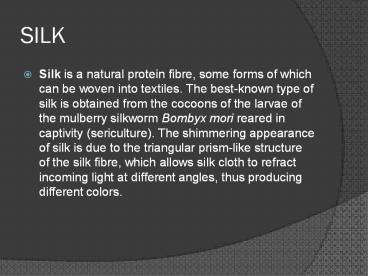SILK - PowerPoint PPT Presentation
Title:
SILK
Description:
SILK Silk is a natural protein fibre, some forms of which can be woven into textiles. The best-known type of silk is obtained from the cocoons of the larvae of ... – PowerPoint PPT presentation
Number of Views:3129
Avg rating:3.0/5.0
Title: SILK
1
SILK
- Silk is a natural protein fibre, some forms of
which can be woven into textiles. The best-known
type of silk is obtained from the cocoons of
the larvae of the mulberry silkworm Bombyx
mori reared in captivity (sericulture). The
shimmering appearance of silk is due to the
triangular prism-like structure of the silk
fibre, which allows silk cloth to refract
incoming light at different angles, thus
producing different colors.
2
Wild silk
- A variety of wild silks, produced
by caterpillars other than the mulberry silkworm
have been known and used in China, South Asia,
and Europe since ancient times. However, the
scale of production was always far smaller than
that of cultivated silks. They differ from the
domesticated varieties in color and texture, and
cocoons gathered in the wild usually have been
damaged by the emerging moth before the cocoons
are gathered, so the silk thread that makes up
the cocoon has been torn into shorter lengths.
Commercially reared silkworm pupae are killed by
dipping them in boiling water before the adult
moths emerge, or by piercing them with a needle,
allowing the whole cocoon to be unraveled as one
continuous thread. This permits a much stronger
cloth to be woven from the silk. Wild silks also
tend to be more difficult to dye than silk from
the cultivated silkworm.
3
Macro structure
- Silk is a natural protein filament. Its density
is 1.34 g/cm cube which makes it a medium weight
fibre. - raw silk strand consists of two silk filaments
encased by a protein called sericin. This sericin
gives raw silk a coarser handle. Sericin is also
very weather resistant since it can withstand
prolonged weather exposure. - Shiny silk filaments are revealed when sericin
is removed in mild alkaline solution. - Silk is a fine, regular, translucent filament.
It may be 600m long but average about 300 m in
length. - Its cross-section may vary from 12µm to 30µm.
this gives fibre length to breath ration in
excess of 20001. - The beauty and softness of silk is due to the
triangular cross-section of silk filament. As
silk filament is tightly twisted and angle of
reflection changes continuously. As a result, the
intensity of reflected light is broken resulting
in a soft subdued luster.
4
Micro-structure
- The irregular, random, longitudinal view of silk
filaments are not sufficiently distinctive to
identify silk under the microscope. The
triangular cross-section can be used to identify
silk. This appearance is due to the slit-like
opening of the silk secreting glands, one being
located on either side within the mouth of the
silk moth larvae. - Silk is a coagulating stream of fibroin solution,
and has no identifiable micro-structure. In this
regard it resembles the man-made fibres.
5
Silk polymer
- Silk polymer is linear, fibroin polymer. fibroin
is the name of protein which constitutes silk. - Silk polymer is composed of 16 different amino
acids. Three amino acids called Alanine, glycine
and serine make up about fourth-fifth of silk
polymer. - Silk polymer is not composed of any group
containing sulphur. Hence it does not contain any
disulphide bonds. - The silk polymer occur only in beta
configuration. Silk polymer is about 140 nm long
and 0.9 nm thick. - Silk is considered as being composed of layers of
folded, linear polymers. That explained the high
crystallinity i.e. its crystalline regions are
65-70 and amorphous region are 30-35.
6
Silk fibre
- Silk polymer system contains no disulphide
bonds. - Like wool the repeating unit of silk is amino
acid. - Important chemical grouping is of silk polymer is
peptide groups. - The major forces of attraction are thought to be
hydrogen bonds. These are only effective across a
distance less than 0.5 nm.
7
Properties
- Tenacity
- Silk is strong fibre. Its strength is due to its
beta-configuration, linear structure and very
crystalline polymer. these two factors permit
many more hydrogen bonds to be formed in a much
more regular manner. Usually 30.9 44.1 cN/tex.
Wet strength is 75 to 85 prcnt of dry strength. - When wet silk loses strength. This is due to
water molecules hydrolyzing a significant number
of hydrogen bonds. - Elastic nature
- Silk is considered to be more plastic than
elastic. Because its a crystalline polymer it
does not allow polymer movement which could occur
in amorphous region. - Its handle is regarded as soft because of the
smooth, even, and regular surface of silk
filament. - Hygroscopic nature
- Because its a crystalline polymer, its less
absorbent than wool. - Thermal properties
- Silk is more sensitive to heat than wool. This
due to the lack of covalent linkages in the
polymer system. The salt linkages, hydrogen bonds
tend to break when temperature reaches 100C.
8
- Moisture regain is 11.
- Specific gravity is 1.25.
- Effect of sunlight
- Sunlight tends to encourage the decomposition of
silk by atmospheric oxygen. - Electric properties
9
Chemical properties
- Acid causes immediate breakdown of silk polymer
because there are no covalent linkages between
silk polymers. - Alkaline solution cause silk filament to swell.
Initially alkali will separate the silk polymers
from each other. Prolonged exposure will
hydrolyze peptide bond, resulting in polymer
degradation and complete destruction of silk
polymer. So yellowing of white or dulling of
colored textile occurs during laundering. It is
due to rearrangement of polymers. - Effect of bleach is same as wool.
- The resistance to environment is not as good as
that of wool. This low resistance is due to lack
of covalent cross linkages.

